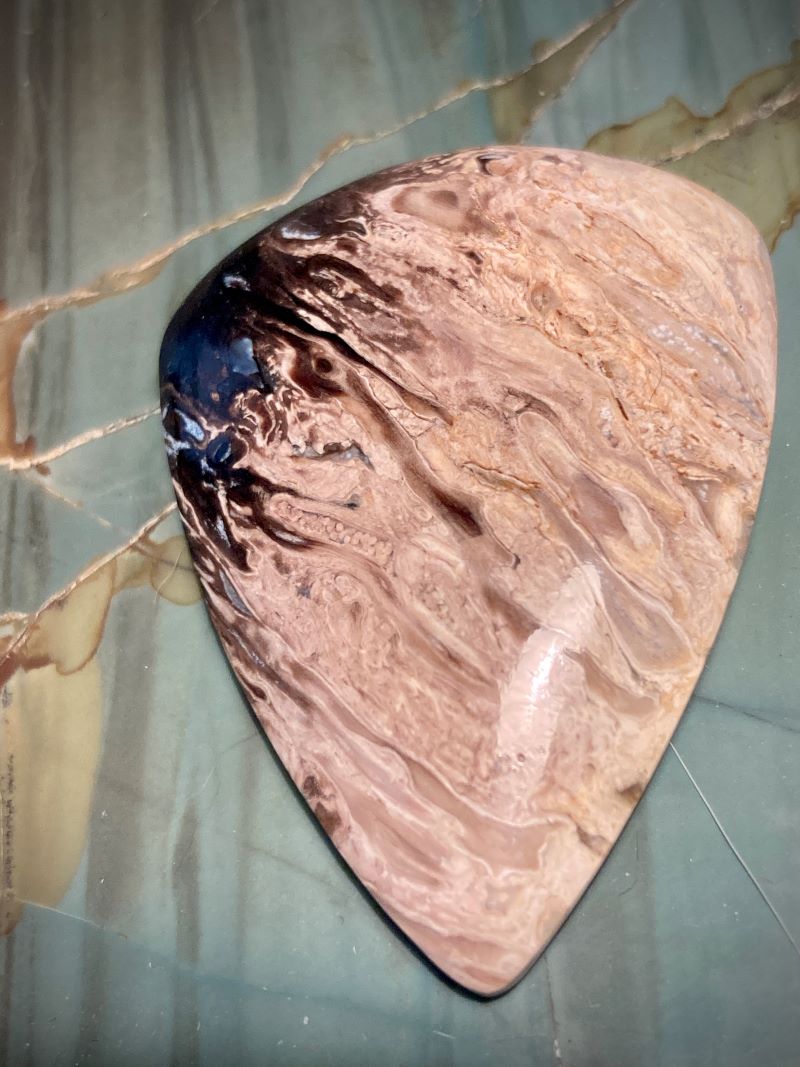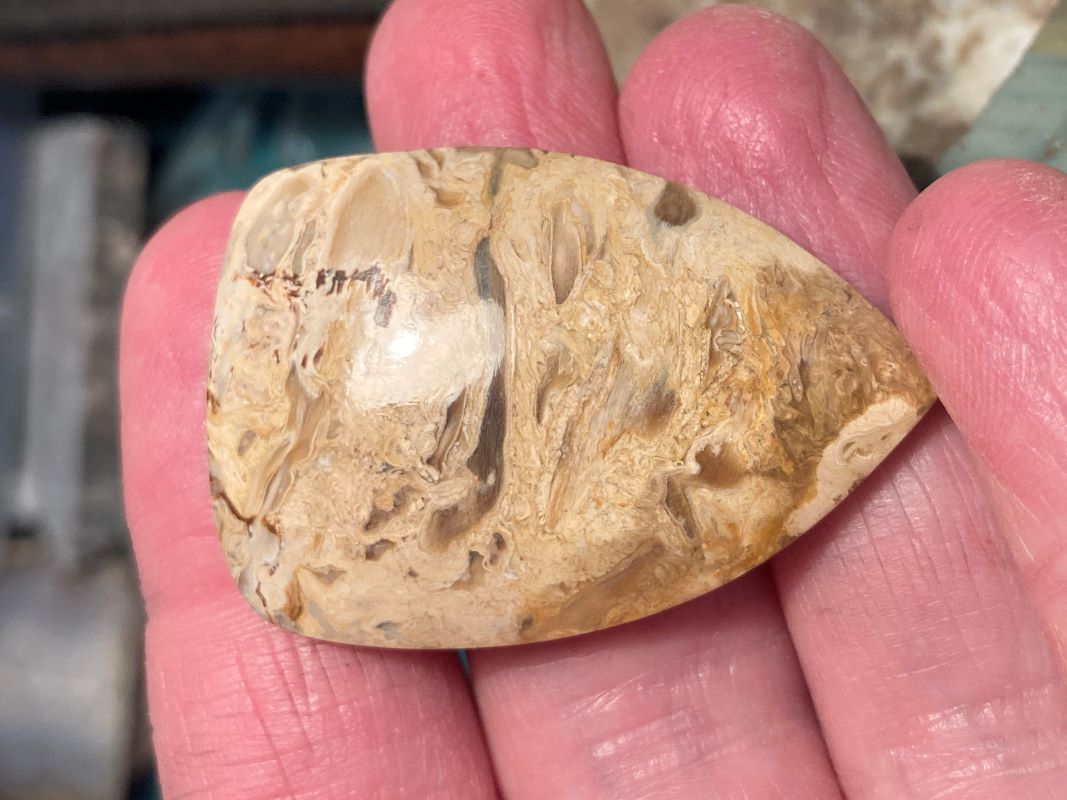RockingRuralMo
starting to spend too much on rocks
 
Member since July 2022
Posts: 137
|
Post by RockingRuralMo on May 16, 2024 9:15:26 GMT -5
i bought a 50K diamond belt to go on an expando drum because i wanted another way to polish live edges, pieces with open vugs, and pretty much anything that undercuts because I've not had good luck getting cerium out of textured spots. I've not used the belt much yet, but would be interested in hearing more experienced people's take. Are these two equivalents? Or do people still use Cerium after a 50k belt?
Some of my first results are below. They're not terrible, but I'm underwhelmed. It's possible I'm not spending enough time on that belt, or maybe should have gone with a 14k instead of 50, or maybe need to do cerium after the belt. But I'm not thrilled with the results yet, and would be grateful for any advice for managing things that are likely to retain cerium.
  |
|
gemfeller
Cave Dweller 
Member since June 2011
Posts: 4,059 
|
Post by gemfeller on May 17, 2024 14:34:15 GMT -5
What grit sequence do you use before the 50K?
|
|
RockingRuralMo
starting to spend too much on rocks
 
Member since July 2022
Posts: 137
|
Post by RockingRuralMo on May 17, 2024 15:09:31 GMT -5
What grit sequence do you use before the 50K? I go to 3k on my cabber, then to the 50k belt. My previous sequence had been 3k to cerium, so I only swapped out that last step. |
|
gemfeller
Cave Dweller 
Member since June 2011
Posts: 4,059 
|
Post by gemfeller on May 17, 2024 15:27:23 GMT -5
What grit sequence do you use before the 50K? I go to 3k on my cabber, then to the 50k belt. My previous sequence had been 3k to cerium, so I only swapped out that last step. I think that's too great a jump. You probably need 8k & 14K before 50K. Cerium, tin oxide and others sometimes seem to help as a final polish, depending on the material. You have to experiment a bit. Sometimes a LOT! |
|
lapidary1234
spending too much on rocks
  "If you like rocks you can't be all bad!!" ~ old timer quote
"If you like rocks you can't be all bad!!" ~ old timer quote
Member since October 2021
Posts: 293
|
Post by lapidary1234 on May 27, 2024 16:54:55 GMT -5
I asked a similar question to this but unfortunately didn't really get many answers.
My question was of anyone knew the approximate grit equivalent of tin / cerium oxide?
This question came to me bc I have raybriteA that kingsley lists at ~25,000 grit. The actual package it came in says .5 micron. The conversion chart i have says .5 micron is 60,000.
I also have "rapid polish #61" from MN lapidary supply. This is listed in their catalog as .25 micron and Val told me its around 75,000 grit.
Then you have your fine grit nova wheels (8,000/14,000/50,000)
After doing experiments, the rapid polish on felt does produce a very glossy polish but as with any compound it embed anywhere it can.
The finer grit nova wheels seem to produce an equally glossy shine.
Still haven't had anyone tell me an approximate grit equivalent for tin /cerium oxides.
Tldr: if your main complaint is compound embedding in stones, I've had great success using the sequence of finer wheels. I'll second what the other poster said about jumping to 50,000 from 3,000 is likely too large a jump.
|
|
|
|
Post by chris1956 on May 27, 2024 18:03:40 GMT -5
I use 3K, 14K, and 50K wheels on my cabber. I mainly use the 14K and 50K wheels for softer stones like Petoskey stones. I was having problems with the polish getting in the small holes. Not sure that it is necessary for harder material.
|
|
lapidary1234
spending too much on rocks
  "If you like rocks you can't be all bad!!" ~ old timer quote
"If you like rocks you can't be all bad!!" ~ old timer quote
Member since October 2021
Posts: 293
|
Post by lapidary1234 on May 28, 2024 18:50:35 GMT -5
So I did a little digging and found that kingsley north says:
"super cerium oxide" has a range of particles .8-1.2 micron. The conversion chart I found equates that to ~14,000-28,000
Also according to kingsley:
Tin oxide is .8 or 28,000 grit.
Take this with a grain of salt (or whatever choice compound) as i bought some raybriteA from them and in a reply to a customer question they say raybriteA is approx 46,000 grit, the box i received says .5 micron on it and the conversion there would be 60,000 (assuming the conversion chart is accurate.
Long story short, it seems that using diamond wheels up to 50,000 gives you a finer abrisive than using tin or even super cerium oxide. Unless there are other qualities that tin or cerium provide it is simply more efficient (for me at least) to use the finer wheels vs preparing a slurry and having to clean little bits out of crevices.
If someone wanted to polish further than a 50,000 grit wheel, you could then use aluminaA (linde, raybrite, etc), "rapid polish #61", or of course diamond compound.
Hope that clears a thing or two up (it did for me).
|
|
RockingRuralMo
starting to spend too much on rocks
 
Member since July 2022
Posts: 137
|
Post by RockingRuralMo on May 29, 2024 16:11:42 GMT -5
thank You everyone! I'm going to order a 14k belt to work into my process, and have already bought a small and cheap ultrasonic cleaner. Between those things maybe I can get a better polish on more stuff. I appreciate everyone's input!
|
|
lapidary1234
spending too much on rocks
  "If you like rocks you can't be all bad!!" ~ old timer quote
"If you like rocks you can't be all bad!!" ~ old timer quote
Member since October 2021
Posts: 293
|
Post by lapidary1234 on Jun 9, 2024 21:56:43 GMT -5
Also, just saw on this website, eastwinds cerium oxide resin bonded discs (for flat lap) are 1.5 micron. This equates to 13,000 grit using g the gia chart found here: www.gemsociety.org/article/gem-cutting-abrasives-grit-mesh-microns/Furthermore, the description for these discs says to use them wet. This has been a question asked in a few places about the cerium oxide wheels available for cabbing machines. I personally haven't ever used a cerium oxide disc of any sort (i charge a felt pad) but the traditional way its done is mostly dry...a couple of mists with water here and there. This information about micron size of polishing compounds is proving very useful since I now have finer grit wheels. I have been getting excellent results using "rapid polish #61" on stuff after the 50,000 grit wheel. Even there though, Its really an unnoticeable improvement over the 50,000 grit. Anyways, eastwind cerium oxide discs are 1.5 micron (13,000 grit) and used wet. ~Josh |
|















